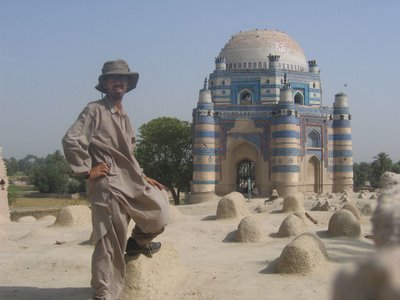In India very often the "things to see" are the ubiquitous Hindu temples, with their riotous colours, colourful rituals and ritualistic statues. Here in Pakistan, the population being Muslim (just in case you didn't already know), that sort of imagery is seen as being rather blasphemous and so is frowned upon. Instead they are particularly fond of shrines, tombs, mausoleums and cenotaphs; or graves to you and me. This morbid habit stems from the fact that Islam forbids depictions of people or deities, and so people's architectural talents turned towards mosques and mausoleums. Pakistan has a particularly abundant supply of the latter so I decided to do a little tomb raiding of my own. OK, so I might not have Lara Croft's tits, guns or hotpants (actually I'd like to see her try doing her thang here in Pakistan dressed in her normal getup: she'd be surrounded by hordes of libidinous, sex-starved men faster than you can say "Angelina Jolie can't act"); but I have invested in a shalwar-kameez combo so that I can blend in with the locals. OK, I still don't do much blending, but I'm really liking the clothes which are extremely comfy and manage to keep you quite cool in the scorching sun.
So my tomb tour started in Lahore with the mausoleum of Jehangir, the 4th Mughal emperor (nice, but not a patch on the other Mughal graves). Then it was down to southern Punjab and the city of Multan. The Punjab, though covering less than a quarter of Pakistan's total area, is home to over half the population. The Punjabis therefore have a stranglehold on national politics and culture. And, to be able to support such a population, the land is rather boring: flat, khaki and dusty. Multan is known as the city of saints due to the many Sufi saints buried there. And since it's auspicious to be buried close to a saint, the outskirts of the old town are full of graveyards. The town itself though is nothing much to speak of, but it's entertaining to wander around the winding back-alleys of the old town and discovering the many saintly tombs. One, in particular, caught my attention as the inside of the building was covered in mirror mosaics, so that even with a very small amount of light entering the place was brightly lit up. From there it was even further south to Uch Sharif, another dusty little nothing town whose dead population outnumbers the living by more than 10 to 1. The big draw is the tomb of Bibi Jawindi (see below) who, ironically enough, wasn't even a Sufi saint. But now I've had enough of the heat, the dust and the pollution and am making and about turn and heading north.
So my tomb tour started in Lahore with the mausoleum of Jehangir, the 4th Mughal emperor (nice, but not a patch on the other Mughal graves). Then it was down to southern Punjab and the city of Multan. The Punjab, though covering less than a quarter of Pakistan's total area, is home to over half the population. The Punjabis therefore have a stranglehold on national politics and culture. And, to be able to support such a population, the land is rather boring: flat, khaki and dusty. Multan is known as the city of saints due to the many Sufi saints buried there. And since it's auspicious to be buried close to a saint, the outskirts of the old town are full of graveyards. The town itself though is nothing much to speak of, but it's entertaining to wander around the winding back-alleys of the old town and discovering the many saintly tombs. One, in particular, caught my attention as the inside of the building was covered in mirror mosaics, so that even with a very small amount of light entering the place was brightly lit up. From there it was even further south to Uch Sharif, another dusty little nothing town whose dead population outnumbers the living by more than 10 to 1. The big draw is the tomb of Bibi Jawindi (see below) who, ironically enough, wasn't even a Sufi saint. But now I've had enough of the heat, the dust and the pollution and am making and about turn and heading north.

No comments:
Post a Comment